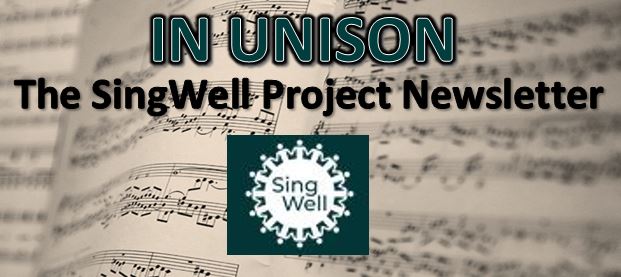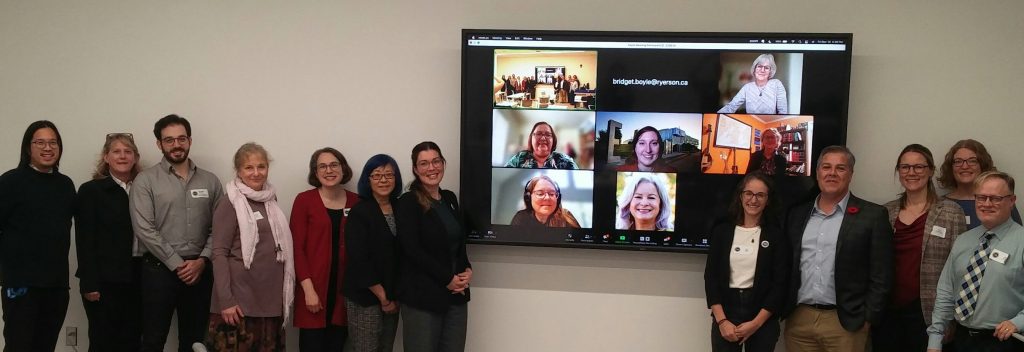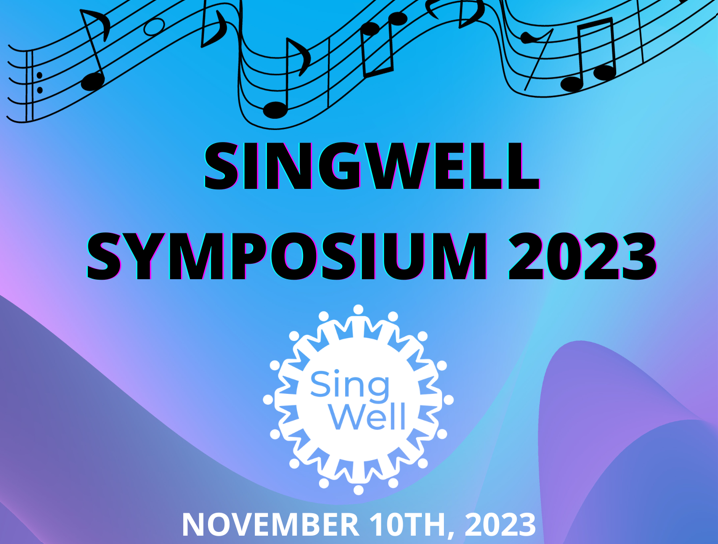

SingWell’s one-day symposium featured a variety of research presentations, a workshop focused on social prescribing, and a special keynote presentation by Dr. Anna Zumbansen, Professor at the University of Ottawa and Assistant Director of the Music & Health Research Institute.
The full list of speakers can be found below. If you would like to learn more about our symposium, or get in touch with one of the presenters, please contact us.
________________________________________________________________________
“Singing for Speech and Language Disorders in Aged-Related Pathologies: From individual to group singing research.”
Keynote presented by Dr. Anna Zumbansen
Because we use the same vocal apparatus to sing and speak, singing appears to be particularly interesting as a therapeutic tool in speech-language pathology. This presentation will discuss clinical research in this field, particularly for communication disorders frequently encountered with age, such as aphasia (language impairment) or dysarthria (speech impairment) after stroke or in neurodegenerative conditions. We will show how singing has been used for 50 years by speech therapists in individual therapy, and why group singing is an important avenue of research for this population. Experimental methodologies for evidence-based clinical practice using group singing will be discussed.
* * *
“Biopsychosocial benefits of group singing in chronic obstructive pulmonary disease”
Research presentation by Tara Raessi
From presentation abstract: The aim of this study was to assess whether persons with chronic obstructive pulmonary disease (COPD) experience psychosocial benefits from group singing. More specifically, the objective was to investigate if persons with COPD experience improved self-reported and physiological markers of wellbeing from participating in group singing. A secondary objective was to explore whether the effects of group singing are different between persons with and without COPD. It was hypothesized that group singing would increase community connectedness, improve mood, and reduce self-reported stress. Further, we hypothesized that persons with COPD would experience greater benefits with respect. The findings of this study suggest that group singing may be used to support community connectedness, increase mood, and reduce stress in individuals with and without COPD. Although individuals with COPD had higher wellbeing at baseline, both groups obtained similar benefits from group singing.
* * *
“A choir for people who stutter: Potential for well-being and communication”
Research presentation by Dr. Simone Falk and Catherine Des Rosiers
From the presentation abstract:
Stuttering is a rare speech motor disorder that severely impacts speech fluency and thereby communication in ~1% of the adult population. It also has major impacts on people’s well-being, as stuttering often generates stress during social interactions, anxiety, stigma and the feeling of social isolation. Unlike previous studies that focused on singing as a means to enhance fluent speech production, the aim of the present study is to explore the potential benefits of group singing on well-being and communication of people who stutter. We present results from a first “stuttering choir”, a pilot study carried out in autumn and winter 2022-2023 in Montreal in collaboration between members of the BRAMS Laboratory, the Singwell network and the Association Bégaiement Communication (ABC). Our objectives were to observe potential beneficial effects of a group singing activity on well-being, communication, stigma, vocal abilities and articulation of adults who stutter. Ten adults who stutter sang together for 10 weeks during the fall and winter sessions at Montreal’s Center of World Musicians. Before and after the choir, the choir members were evaluated by questionnaire in
relation to the perception of their well-being, their musical abilities and their stuttering. Speech production and vocal/musical abilities were also assessed with singing, rhythm, conversation and reading tasks. During two choir sessions they were also assessing vocal synchrony of our participants and pain thresholds before and after the activity in order to
evaluate whether singing had potential effects on resilience. In their presentation, Dr. Falk and Ms. des Rosiers presented the concept of the choir, first results showing for example that group singing had the
potential to reduce stigma, and discussed how to reduce barriers and enhance participation of adults with stuttering to join a group singing activity.
* * *
“Improving Automated Pitch Analysis of Online Singing Test Results: Can a post-processing algorithm for pYIN data reach the accuracy of Praat-assisted Human analysts?”
Research presentation by Dr. Annabel J. Cohen
From the presentation abstract:
The acoustic analysis of singing offers a rich source of information about vocal motor control. Human note-by-note analysis of singing (e.g., aided by Praat) can be highly accurate but extremely labour-intensive. Automated analysis in contrast is impressively fast but less accurate. One computational problem is that of segmentation of the melodic acoustic stream into discrete notes. Here we focus on errors of commission, that is, when pYIN identifies more pitches than the singer intended (e.g., arising when a singing scoops up or down to a target pitch). We
developed an automated approach to overcoming this problem in the analysis of pitches (.wav files) produced during our online singing test (drawing on Silas et al., 2023 and Cohen et al., 2020). We illustrate this with data from 14 participants who completed the singing test requiring imitation of 20 tone sequences, from 1 to 6 notes in length, representing basic structures of the Western tonal music. The complete set entailed 60 pitches, sung on both /da/ and /du/ syllables, thus totaling 120 pitches.
The pitch analysis algorithm, based on pYIN showed very high agreement (r = .99) with the expert human pitch analysis aided by Praat, but only for trials in which the number of pitches found by pYIN
equaled the number of pitches sung (i.e., no commission errors for the trial and representing ~60% of all pitches sung). For singing test results that in contrast included pYIN produced errors of commission,
as a baseline for comparison, we created Model-R which randomly removes excess pitches for each trial. Model-R provided a relatively poor fit of r = .71 (SD = .20) to the human analysis. We then created three
models based on assumptions of pitch proximity and duration and tested the models against both Model-R and the expert human pitch analysis. The new model based on recursively averaging pairs of
most proximate pitches produced very high correlations with the human analysis (r = .96, SD = .04) and significantly exceeded the results of Model-R (z = 2.54, p < .011). It is concluded that application of this algorithm to pYIN output may be sufficient to replace the need for human analysis for large vocal data sets.
* * *
“Sing-a-Lung: Singing as training modality in pulmonary rehabilitation for patients with Chronic Obstructive Pulmonary Disease (COPD): A multicenter, randomised controlled trial”
Research presentation by Dr. Mette Kaasgaard
From the presentation abstract:
Pulmonary rehabilitation (PR) is a cornerstone in COPD care and includes Physical Exercise Training (PExT) as a key component. However, PR adherence and upkeep after PR are challenged and there is an increasing request for alternative or supplementary evidence-based
activities in PR. Singing has been suggested to improve quality of life (QoL) and respiratory aspects and to be a motivating activity to support upkeep. However, the body-of-evidence is scarse and with
contradictory findings. Moreover, the impact on physical capacity and the relevance of singing in PR is unknown.
Between 2017 and 2019, we conducted a multicentre, randomised controlled trial (RCT) (NCT03280355) comparing the current best-practice approach, Singing for Lung Health (SLH), with standard PExT within a 10-week, community-based PR programme for COPD. SLH conferred clinically relevant physiological and psychosocial
changes in COPD after a short-term programme within community-based PR, and the study demonstrated non-inferiority to PExT. Furthermore, we found a dose-response relationship between
adherence and improvements of 6MWD and SGRQ and equal adherence in SLH and PExT. Further high-quality studies are needed to confirm these short-term findings to build a robust body-
of-evidence if singing were to be considered within in a more personalised future PR offer. Long-term impact of singing on upkeep of activity, sustain of short-term effects, COPD exacerbation rate, and health-economic aspects are unknown. Furthermore, there is a need to explore mechanistic, physiological factors related to singing in COPD and to investigate effect targeted specific phenotypes. Lastly, there is a need to clarify optimal content and delivery of singing methodology in
COPD and in other lung diseases.
* * *
“‘I tell people, I’m a chorus person’: Exploring the impact of long-term aphasia choir participation on renegotiating positive post-stroke identity”
Research presentation by Ellen Bernstein-Ellis and Christy Thies
From presentation abstract:
The last decade has seen a steady growth of aphasia and mixed neuro choirs around the globe. The Aphasia Tones Choir was established in 2009 aligning with the Life Participation Approach to Aphasia (LPAA) framework that promotes participation in popular, meaningful adult activities. While participation in aphasia groups has been shown to contribute to renegotiating a positive post-stroke identity, and both aphasia groups and aphasia choirs are a recommended intervention for psychological well-being, there is limited research examining the impact of long-term participation in aphasia choirs.
* * *
“How can action research improve professional practice to maximise the benefits of community singing for adults with acquired neurogenic communication difficulties?””
Research presentation by Alison Talmage
From presentation abstract:
How can action research improve professional practice to maximize the benefits of community singing for adults with acquired neurogenic communication difficulties? I have approached this question through my music therapist’s lens, with sub-questions focusing on the relationship between practice and research, musical considerations in a tailored programme, choir member demographics, group composition and
dynamics, framing and documenting outcomes, and professional identity and skills. The study has unfolded in seven action research cycles, some in parallel in an innovative research design. Data collection and analysis methods include audio-visual analysis, qualitative document analysis, musical analysis, interviews, focus groups, reflective thematic analysis, poetic and narrative analysis, and a reflexive research
journal. The impact of the covid-19 pandemic on practice and data collection is also considered. My findings are presented as the VOCCAL Framework – Vision, Outcomes, Conventions, Communities,
Administration, and Leadership. While action research occurs in a specific context, the concepts and options in the framework allow generalization to other settings. This meets the preference of New Zealand practitioners for flexible protocols (Talmage & Purdy, 2021). The main output of my study will be a handbook to resource both my
own practice and other facilitators in this field. Choir members will contribute to dissemination and advocacy through songs created for and with the choir (Talmage, 2022; Talmage et al., 2020).
* * *
“’Acting as one’ as a motivator and mechanism for coordination and connection in group singing”
Research presentation by Dr. Janeen Loehr
From presentation abstract:
People sometimes experience a sense of “acting as one”, or acting together as a single unit, when they coordinate their actions with others, such as when dancing, playing team sports, or singing together in a choir. One member of a large community choir described such an experience as follows, “It’s almost like you become—you’re not 200 individual people, you’re one person, one entity that’s working together” (Stephens, 2021, p. 16). First-hand accounts of acting as one (AAO) have been reported in a variety of settings, including both large- and small-group music-making. Some of these reports have linked the experience of AAO to coordination during group music-making and to positive outcomes after group music-making, such as positive emotions and social bonding among those who shared in the experience. However, systematic evidence is scant regarding the factors that promote AAO and its effects on individual and collective well-being. We therefore conducted an online survey that used the Critical Incident Technique to collect detailed written accounts of memorable experiences of AAO during group-music making. We collected 77 accounts from 51 participants, approximately half of which reported an experience of AAO during group singing. Thematic analysis of these accounts shed light on the contexts in which AAO is likely to arise, revealed details of the phenomenology of the experience (what it feels like for people), and indicated that AAO can have a powerful impact on people’s emotions, sense of meaning, and sense of connection to other group members. We are currently working to develop a measurement scale that can be used to assess experiences of AAO during group activities, which we hope can be used as a tool to further investigate AAO’s role in facilitating coordination, connection, and positive personal and social outcomes of group singing.
* * *
“Tools for physiological and behavioural data collection in multi-subject singing research”
Research presentation by Dr. Dawn Merrett
From presentation abstract:
While preparing for her SingWell-funded study on group singing, Dr. Merrett and her team worked hard to find optimal solutions for obtaining physiological, behavioural, and mood data. In her presentation, she shared what they discovered about the pros and cons of various tools and some important methodological considerations when collecting multi-subject physiological and behavioural data. She described the development of a new tool for synchronized group physiological data collection that they hope to use in research that is scalable and relatively inexpensive: the BRAMS Bio Box (B3), a collaboration between BRAMS (https://brams.org/) and CRITIAS (https://www.etsmtl.ca/laboratoires/critias). The BRAMS Bio Box currently has the option to collect electrocardiograms (ECG), photoplethysmography (PPG), respiration (though either a thermistor or force-sensing resistor or both), triaxial accelerometry, and audio recordings. Sensor data is written to a micro-SD card, but real-time monitoring and recording is possible through LSL (Lab Streaming Layer, https://labstreaminglayer.org/), open-source middleware that uses a Wi-Fi network to stream sensor-based data. The capabilities and limitations of the B3 were discussed, along with some of the next steps in its validation and development. When optimization and validation is completed, the schematics for the B3 will be made available to provide an affordable, open-source physiology research option. Dr. Merrett also discussed the challenges around capturing mood data and the potential benefits of using software to capture objective measurements of mood states based on facial expressions to supplement traditional self-report mood measures. She outlined their use of commercially available solutions, such as FaceReader™ from Noldus, along with some of the methodological considerations when using it for singing-based research. She also briefly discussed the challenges with synchronizing and annotating all of these data streams.
The presentation forged a discussion about problem-solving around these important methodological considerations for physiological and behavioural data in multi-subject singing research.
Did you know SingWell members get early access to SingWell event information, including our symposium?
Click here to learn more about the different project memberships we offer

Ⓒ 2020-2025, The SingWell Project